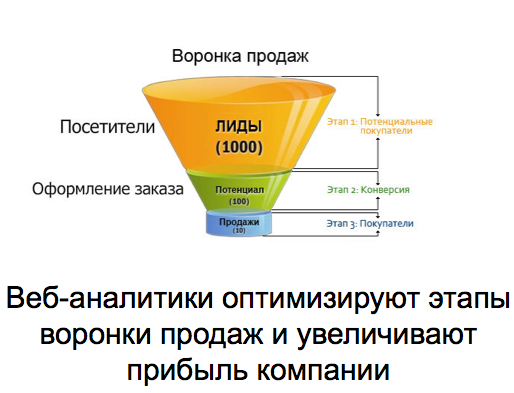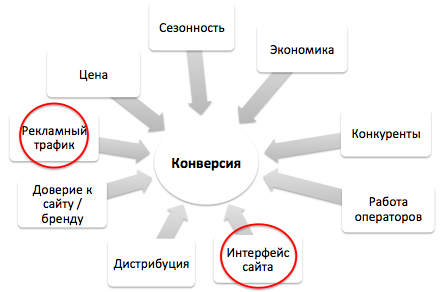Web analytics: why does your business need it?
“Web analytics offers endless possibilities for optimizing and improving not only the site, but also the company's business processes” - COO 1download, Sergey Artemyev.
What do online stores that do not have ecommerce set up lose? What miss service sites that do not have integration with call-tracking? So, what does a site lose or lose in the absence of analytics?
Consider the three most common situations that are most often found on the market.
1) In general, there is no analytics system, or it is incorrectly configured.
Most companies do not collect data at all, and if they collect it, it is often incorrect or incomplete, which is practically the same as the first case. Even if the online store uses Google Analytics, but it is not configured, it is extremely difficult to draw conclusions that are really useful for business from this data. The data is simply not enough.
2) There is analytics, but there is no one to analyze
Another case when all analytics systems are configured, but the company does not have enough professional employees who can correctly analyze this data and draw useful conclusions. There are not enough strong personnel on the market, and not all companies are ready to keep analytics on staff.
3) One-time analytics for some tasks or projects
The third option is when the company needs one-time analytic services, for example, to audit the advertising campaign in order to check the contractor how well he fulfills his obligations.
There are a lot of analytics systems, but in 90% of cases, Google Analytics and Yandex Metrics are sufficient. Only for very specific areas of business and tasks may some specialized analytics systems be required.
For example, Google Analytics can be used for mobile applications, it can track mobile traffic, you can also set goals and events there, but it’s still an inferior analytics system. Systems such as Kissmetrics, Flurry, MixPanel will come to the rescue.
The Yandex.Metrica webvisor does its job perfectly - it shows the actions of visitors to the site, but there are specialized systems for tracking user behavior that have much more functionality.
Web analytics features
The capabilities of analytics systems are essentially limitless and they can be applied in a wide variety of business sectors for a variety of tasks. For example, employees of a company that develops data processing algorithms figured out how to select the neighborhood of passengers on the plane based on data from social networks, purchase histories, etc. They tested their algorithm on a real flight. At the end of the flight, the flight attendants filled out a questionnaire, and it turned out that it was the most talkative flight of all time. For the airline, the commercial interest of such analytics is to build a loyal audience and increase revenue from the sale of alcohol and souvenirs on board.
But most often site owners want to increase either the number of incoming calls, or the conversion to sales from these calls.

At the same time, many factors influence conversion. But the analyst can affect only two of them:

Thus, one of the directions for analytics can be working with the usability of the site. For example, behavioral analysis is aimed at improving advertising campaigns: we understand how users who come to the site from a certain advertising channel behave, what they did on the site, and what prevented them from buying a product or service. Based on the data obtained, recommendations can be made, for example, on finalizing the interface. Then hypotheses are built, changes are implemented and tested.
To evaluate advertising campaigns with a deferred effect, cohort analysis is useful - this is one of the methods of audience segmentation and data processing for various segments.
Online Store Analytics
The most important thing for an online store is to be able to track the effectiveness of traffic in the context of final orders. The main solution in this case is E-commerce in Google Analytics, which allows you to track all orders made from the site. In the analytics system, the order code, date, source of traffic (advertising, SEO, etc.), the amount of the order, the number of products in the basket, the path that the client walked to the order, etc. are recorded. Thus, it becomes possible to evaluate and compare different advertising campaigns.

What does it give? First of all, you can evaluate how effective paid advertising channels are. Knowing the advertising costs in Yandex.Direct, the number of orders received and the average check, you can, for example, calculate the ROI and determine whether this advertising channel pays off or not. But the assessment of traffic sources is only the highest level.
Digging deeper, you can see which keywords lead to sales. According to experience, 80% of keywords from all advertising campaigns in the market generally do not contribute to sales. With the help of analytics, you can identify the very 20% of keywords that affect direct sales, and greatly reduce advertising budgets, while maintaining efficiency. But not everything is so simple, it is always necessary to take into account the interconnection of channels (“associated conversions”).
The user’s path from the first visits to the site to conversion can be very long. It’s rare when a customer comes for the first time from advertising and immediately buys something on the site. Usually this is a longer chain: the visitor came to the site through contextual advertising, returned via search, then entered the product’s card from his mobile device, which he set aside for himself, and made the order from a stationary PC by directly accessing the site. By disabling one of the channels, even if it does not bring sales here and now, we risk breaking this chain. And all this data can and should be analyzed. In terms of web analytics, this is called "multi-channel sequences."

To assess the impact of the traffic channel on sales, there are so-called “attribution models”. For example, a site has three traffic channels: contextual advertising, SEO, and banner advertising. Each channel affects sales differently. For example, banner advertising does not bring direct conversions, but in 50% of cases it participates as a source of customer conviction for the final sale. Without it, this chain will break, and sales, for example, in the context will fall. When assessing the cost of customer acquisition and the cost of conversion, you can take into account the influence of channels, taking into account various factors. The presence of all these data and a specialist who will regularly monitor and analyze them will allow you to correctly configure the effective interaction of all advertising channels.
Analytics for the site services
Service sites in general have a similar picture, but there is a slightly more complicated situation associated with a longer sales cycle. In many areas of business, it may take several months from the first visit to the site to the sale. The second problem is that the analytics chain is interrupted at the moment when the client contacts the manager, and then all communication takes place offline or in the CRM system. It turns out that we know when and from what source the client came to the site, but no one knows what happened to him next. In most cases, all analytics stop at this point, and few people know what to do next. As a result, about 95% of companies simply consider the cost per application, this becomes a key metric.
This will indirectly show the effectiveness of traffic, but each channel is converted differently, so this data is clearly not enough. For example, contextual advertising can give a large number of requests, but with a low conversion, and a retargeting campaign can bring a similar number of requests, but with a conversion of not 10%, but 60%. Without deeper analytics in conjunction with sales data, it is difficult to assess which channel works more efficiently. After all, business is not measured by applications, but by sales. There are several solutions for collecting such data. The simplest is the integration of Google Analytics with the internal CRM / ERP system. In fact, any systems that store sales information can be integrated with Google Analytics.

As a result, information about orders at the moment they were placed in Google Analytics will appear. This can happen two months after visiting the site, while any device with Internet access can sell and transfer data about it to Google Analytics, even a warehouse barcode scanner. Such information is recorded in the desired traffic source and the desired keyword. This will be pending statistics, but it will still appear in the system. In any case, you need to analyze the advertising campaign only after a certain period, which depends on the sales cycle.
Incorrect settings
There are problems with incorrect settings in the existing analytics system. Inaccurate order data, when it is duplicated or incorrectly read, incorrect conversion data, unconfigured filters - all this affects the overall statistics. Sometimes critical. You can not consider the web analytics system as a sales accounting system, there will always be a certain percentage of error, but you can try to minimize it due to the correct settings.
If we compare Google Analytics and Yandex.Metrica, then they have approximately the same level of error, but, from the point of view of completeness of data, analytics from Google provides much more opportunities. In Yandex.Metrica, for example, only recently appeared an analogue of electronic commerce, which has been successfully working at Google for many years. At the same time, Yandex.Metrica, of course, has its own unique advantages - a web browser, click and link maps, and form analytics.
To optimize advertising channels and budgets, increase the conversion to orders from the site and other opportunities to improve business performance gives a well-chosen and tuned web analytics.
